Free Online Productivity Tools
i2Speak
i2Symbol
i2OCR
iTex2Img
iWeb2Print
iWeb2Shot
i2Type
iPdf2Split
iPdf2Merge
i2Bopomofo
i2Arabic
i2Style
i2Image
i2PDF
iLatex2Rtf
Sci2ools
DAGM
2005
Springer
2005
Springer
Object Categorization and the Need for Many-to-Many Matching
Abstract. Object recognition systems have their roots in the AI community, and originally addressed the problem of object categorization. These early systems, however, were limited by their inability to bridge the representational gap between low-level image features and high-level object models, hindered by the assumption of one-to-one correspondence between image and model features. Over the next thirty years, the mainstream recognition community moved steadily in the direction of exemplar recognition while narrowing the representational gap. The community is now returning to the categorization problem, and faces the same representational gap as its predecessors did. We review the evolution of object recognition systems and argue that bridging this representational gap requires an ability to match image and model features manyto-many. We review three formulations of the many-to-many matching problem as applied to model acquisition and object recognition.
| Added | 26 Jun 2010 |
| Updated | 26 Jun 2010 |
| Type | Conference |
| Year | 2005 |
| Where | DAGM |
| Authors | Sven J. Dickinson, Ali Shokoufandeh, Yakov Keselman, M. Fatih Demirci, Diego Macrini |
Comments (0)

